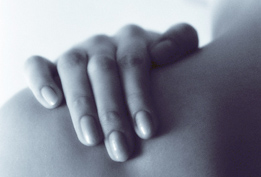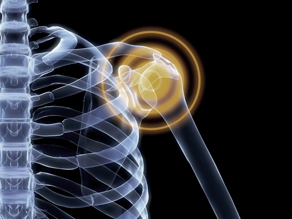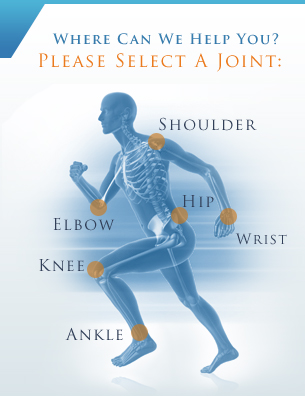
Procedures: Shoulder
|
|
Shoulder Dislocation Treatment
 The shoulder is a "ball-and-socket" joint where the "ball" is the rounded top of the arm bone (humerus) and the "socket" is the cup (glenoid) of the shoulder blade. A layer of cartilage called the labrum cushions and deepens the socket. A dislocation occurs when the humerus pops out of its socket, either partially or completely. As the body's most mobile joint, able to move in many directions, the shoulder is most vulnerable to dislocation.
The shoulder is a "ball-and-socket" joint where the "ball" is the rounded top of the arm bone (humerus) and the "socket" is the cup (glenoid) of the shoulder blade. A layer of cartilage called the labrum cushions and deepens the socket. A dislocation occurs when the humerus pops out of its socket, either partially or completely. As the body's most mobile joint, able to move in many directions, the shoulder is most vulnerable to dislocation.
Dislocation causes pain and unsteadiness in the shoulder. Other symptoms may include swelling, numbness, weakness and bruising. The majority of dislocations occur when the humerus slips forward, a condition called anterior instability. This may happen during a throwing motion. The humerus is also capable of dislocating backwards or downwards. In most cases, the dislocated shoulder can be manipulated back into place by a doctor in a process known as closed reduction.
Complications of shoulder dislocation or reduction can include a labrum or cartilage tear, a lesion on the glenoid bone after the humerus strikes it, tendon or ligament injuries, and blood vessel and nerve damage. Shoulders that have dislocated once are more likely to dislocate in the future, potentially resulting in chronic shoulder instability and weakness.
Shoulder Impingement Treatment
The shoulder joint is one of the most flexible and complex joints in the entire human body. It is also one of the most vulnerable joints, making it a frequent victim of various disorders and syndromes. One of the most common causes of pain in the shoulder is impingement of the soft tissue within the mobile joint.
Any bodily condition that constricts the narrow space that the rotator cuff tendons pass through can be considered a cause of shoulder impingement. This problem is regularly caused and exacerbated by conditions such as bursitis and rotator cuff tendonitis, but can also evolve from:
- Bone spurs
- Ligament calcification
- Misshapen/malformed acromion
- Tear in rotator cuff
The only true symptoms of impingement are pain, loss of movement, and weakness in the affected shoulder. These symptoms are quite broad and cover many other possible problems in the shoulder joint, necessitating various imaging techniques in order to make an accurate diagnosis. X-rays can help detect join malformation or bone spurs, while ultrasonography, magnetic resonance imaging and arthography may be used to identify various rotator cuff tissue pathologies.
Shoulder impingement is generally a chronic disorder and will usually get worse over time. Treatment is conservative, however, consisting of rest and physical therapy with non-steroidal anti-inflammatory drugs (NSAIDs).
The effectiveness of corticosteroids in treating shoulder impingement is highly debated but still considered a course of action in certain cases. The injections may reduce swelling in various tissues around the tendons but are prone to cause further musculoskeletal problems.
In severe cases, arthroscopic surgery and open surgery are considered viable options. This is especially true concerning abnormal bone formations and spurs, as this is the only guaranteed method of removal. Several surgical procedures may be utilized depending on the cause of the impingement. Recovery from surgery can take up to a year to conclude, but in most cases is less than half that time.
SLAP Lesion Repair
 Although the shoulder is considered a "ball-and-socket" joint, the glenoid fossa "socket" covers less than one third of the humeral head "ball" at any one time. This tissue, known as the glenoid labrum, is formed by the cartilaginous extensions of the biceps origin.
Although the shoulder is considered a "ball-and-socket" joint, the glenoid fossa "socket" covers less than one third of the humeral head "ball" at any one time. This tissue, known as the glenoid labrum, is formed by the cartilaginous extensions of the biceps origin.
This area is vulnerable to a specific injury known as a Superior Labral tear/lesion from Anterior to Posterior. This is similar to a Bankart lesion, except in this case the biceps tendon is not fully separated from the labrum. The SLAP tear is prevalent in high performance throwing athletes, such as baseball pitchers.
Patients with a SLAP lesion typically have limited range of motion in their shoulder and experience pain when moving the joint. The patient may also suffer from persistent dislocating and "catching" sensations when trying to move.
In non-athletes, surgery is not indicated unless pain is consistent and affects the patient's quality of life. Although physical therapy can help promote stability of the shoulder by strengthening the surrounding muscles, there are very few recorded cases where a SLAP lesion victim fully recovered without surgical intervention.
Surgery for a SLAP lesion is relatively quick, lasting less than two hours in most cases, and is done in a minimally invasive manner, utilizing an arthroscope to reduce the chance of infection and recovery time. Both the labrum and glenoid are abraded slightly to increase their surface areas and promote growth.
A varying number of anchors are set in holes drilled into the glenoid; some mild tears may only require one anchor, but more are needed as the severity increases. The anchors allow the labrum to be tied very tightly to the glenoid, ensuring that contact is kept and the tissues will mend together. The recovery for this procedure is lengthy; full recovery takes about a year and return to non-strenuous daily activity takes eight to ten weeks.









